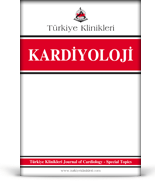Amaç: Sendrom X, eforla gelen göğüs ağrısı, pozitif efor testi ve normal koroner anjiyografi bulgularının varlığında heterojen bir grup hasta için kullanılan bir terimdir. Bu çalışmada amacımız gerçek koroner arter hastaları ile sendrom Xli hastalarda, dilaltı nitratların efor testleri üzerine olan etkilerini inceleyerek, bu noninvaziv metodun iki grup hastayı ayırmada yardımcı olup olamayacağını araştırmaktı. Metod: Çalışma yaş ortalamaları 54±6 olan 10 kadın, 6 erkek toplam 16 sendrom Xli olgu ile, yaş ortalamaları 56±8 olan 2 kadın, 10 erkek toplam 12 koroner arter hastası üzerinde gerçekleştirildi. Eforla gelen göğüs ağrısı şikayeti ile başvuran hastalardan istirahat elektrokardiyografilerinde (EKG) anlamlı iskemik bulgusu olmayan, efor testleri pozitif fakat koroner anjiyografileri normal olan grup sendrom X, anjiografide en az bir ana koroner arterde %75 veya üstünde darlığı olan grup gerçek koroner arter hastalarını oluşturdu. Konjenital kalp hastalığı, kalp kapak hastalığı, kardiyomyopati, konjestif yetmezliği, geçirilmiş miyokard infarktüsü, sistemik hipertansiyonu ve/veya sol ventrikül hipertrofisi olan hastalar çalışma dışı bırakıldı. 3. vizitte çalışmaya alınan hastaların eğer varsa almakta oldukları ilaçlar uygun sürelerle kesilerek 2. kez ve dilaltı isosorbitdinitrat (ISDN) 5 mg verilerek efor testi uygulandı. Her iki efor testinde de hasta gruplarından istirahatte, 1 mmlik ST segment depresyonunda ve maksimum egzersizlerde elde edilen sonuçlar birbirleri ile kıyaslandı.Bulgular: Koroner arter hastalarında dilaltı ISDN verilerek yapılan efor testinde klasik teste göre istirahat kalp atım sayısı arttı, sistolik kan basıncı (SKB) azaldı, sırasıyla (p<0.001), hız basınç çarpımı (rate pressure product (RPP)) ise anlamlı değişme göstermedi. 1 mmlik ST segment depresyonu sırasında kalp hızında, RPP ve 1 mmlik ST depresyonu oluşuncaya kadar geçen sürede istatistiksel olarak anlamlı artışlar gözlendi, sırasıyla (p<0.001). Maksimum egzersizde kalp atım sayısı artarken, SKBı değişmedi, RPP ve toplam egzersiz süresinde anlamlı artış (p<0.001) ve maksimum ST segment depresyon miktarında anlamlı azalma saptandı (p<0.001). Aynı şekilde sendrom Xli hastalarda dilaltı ISDN sonrasında istirahat kalp atım hızı ve RPP artarken (p<0.001), SKBı azaldı (p<0.01). 1 mmlık ST segment depresyonu sırasında SKBı ve 1 mmlik ST segment depresyonu oluş zamanı azaldı (p<0.001), RPPdeki azalma orta derecede idi (p=0.014). Maksimum egzersizde kalp atım sayısı, RPP, SKB açısından her iki efor testi arasında anlamlı fark yoktu. Maksimum egzersiz süresi belirgin olarak azaldı (p<0.001), maksimum ST segment depresyon miktarında artış izlendi (p<0.05). Sonuç: Bizim sonuçlarımıza göre ISDN verildikten sonra sonuçların daha da kötüleşmesi anjiografik olarak normal koroner arterlerin bulunduğunu gösteren güçlü bir kanıttır.
Anahtar Kelimeler: Koroner arter hastalığı, sendrom X, efor testi
Purpose: Vascular syndrome X is the term applied to a heterogeneous group of patients with stable angina pectoris, exercise-induced ischemic ST segment changes and angiographically normal coronary arteries. Our aim was to determine if there was a difference between the parameters of exercise stress testing done with and without sublingual (isosorbiddinitrate (ISDN) in coronary artery disease (CAD) and syndrome X patients and to see if this noninvasive method could be useful in identifying patients with normal coronary arteries. Method: 16 patients (10 female and 6 male) with average age 54±6 years of syndrome X and 12 patients (2 females and 10 males) with average age 56±8 of CAD were included in the study. Patients with a history of stable angina pectoris but normal resting 12-lead electrocardiography (ECG), a positive exercise stress test and normal coronary angiographic findings constituted syndrome X group. If angiographically documented stenosis ³75% of at least one major coronary artery was found, these patients constituted CAD group. Patients with congenital and valvular heart disease, cardiomyopathy, heart failure, previous myocardial infarction, systemic hypertension and/or left ventricular hypertrophy were excluded. Results: On the first visit patients underwent a symptom limited exercise stress test according to a modified Bruce protocol after a suitable period of withdrawal of drugs. Vascular investigations were performed during a second visit. On the third visit exercise stress testing was performed by using 5 mg sublingual ISDN. Test results at rest, at 1 mm ST-segment depression and at peak exercise were compared with each other in both of the patients groups. After ISDN, heart rate increased and systemic blood pressure decreased significantly (p<0.001) and rate pressure product (RPP) showed no change of statistical significance in CAD patients at rest. At peak exercise, systemic blood pressure showed no statistical difference, heart rate, RPP and equivalent exercise time to peak exercise increased and maximal ST segment depression decreasedsignificantly (p<0.001 and p<0.001 respectively). In syndrome X, heart rate and RPP increased while systemic blood pressure decreased significantly (p<0.001) after sublingual ISDN at rest. At peak exercise, heart rate, systemic blood perssure and RPP showed no statistically significant difference. Only equivalent exercise time to peak exercise decreased significantly (p<0.001) and maximal ST segment depression increased moderately (p<0.05). At ischemic threshold equivalent exercise time to ischemic threshold and RPP increased in CAD but decreased in syndrome X patients by sublingual ISDN (p<0.001). Conclusion: In conclusion, the majority of patients with syndrome X showed no improvement in exercise stress testing after sublingual ISDN. Patients with CAD improved their exercise performance and delayed their ischemic threshold. Therefore patients with chest pain and positive exercise stress testing will give us a brief idea to distinguish them if they are CAD or syndrome X patients by using sublingual ISDN in their exercise stress testing.
Keywords: Coronary artery disease, syndrome X, exercise stress testing







.: Process List